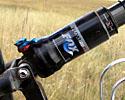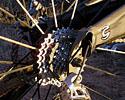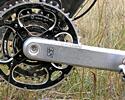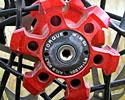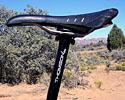
Recently on Cyclingnews.com |
Tech Feature: Cannondale Carbon Rush Product Launch, September 23-24, 20062007 Carbon Rush to Serve Endurance RacersOn a late September weekend preceding Interbike, Cannondale officially released its newest endurance-oriented mountain bike to the assembled media. Sue George was on hand for Cyclingnews to try out the new 'Rush' on some of the unique trails in and near Brian Head, Utah.
For 2007, Cannondale takes its popular off-road, dual suspension Rush mountain bike to a higher level. The new design sheds weight but gains stiffness by converting the frame’s front triangle from an aluminum alloy to a carbon material. The single-pivot Rush is designed for marathon and endurance cross country racers who want a high-performance, lightweight, full suspension bike. Cannondale boasts the Team Rush weight at only 10.75kg (23.7 lbs) with pedals. A few Cannondale-sponsored pros, such as Christoph Sauser, have already raced to World Cup podium success on the new carbon Rush, and Tinker Juarez was on hand for the weekend to hone the fit of his new carbon Rush after racing his alloy version thus far in 2006. After a second media preview in Europe next week, Cannondale will begin selling the 2007 Rush worldwide in late November 2006. In the meantime, demo bikes will be available at some dealers. System IntegrationCannondale prides itself on its “System Integration” or “SI” approach to bicycle design. Marketing Manager Scott Struve observed, “While other manufactures now claim an overall whole-bike design approach, Cannondale has a long history of System Integration. Our proprietary front suspension Headshok design first appeared fifteen years ago in 1992.” The Headshok evolved into the now famous, one-legged Lefty fork. New for 2007 is a carbon monocoque front triangle. Manufactured in Asia, the carbon front triangle allows for more complex shapes and is 300 grams lighter than its alloy cousin—it is molded thicker in some sections to add strength and stiffness in key areas and includes integrated single pivot and shock mounts. An oversized and ovalized top tube provides lateral stiffness, while an oversized and round downtube increases torsional stiffness. Also new is Cannondale’s SI integrated stem and steerer. With the Lefty already requiring its own proprietary steerer tube, Cannondale took the next step to integrate it with the stem. The 3-D forged, one-piece design is reminiscent of the formerly ubiquitous quill stems in that it comes with some similar pros and cons. Fewer total parts save weight, increase front-end stiffness, and reduce parts inventory, but the integration means less position options for any given stem. Gone are the days of juggling stem and spacer positions and flipping the stem to switch from positive to negative rise. However, Cannondale provides all dealers with a kit containing nine different sizes of integrated stems and steerers to help customers achieve perfect fit during bike set-up. Another example of SI, Mavic customized the front axle of its Crossmax SLR hub for compatibility with the Lefty. The result is a lighter (by 50 grams) and stiffer interface between the fork and front hub. All wheels, hubs, and spokes are Mavix Crossmax SLR UST (tubeless). The SuspensionThe SI approach is perhaps most evident in the suspension design. Cannondale simultaneously designed its rear and front suspension to compliment each other. Both front and rear travel measures 110 mm. Working closely with Fox to customize rear shock performance, Cannondale adjusted the Lefty shock to match. For the Rush, Cannondale has deliberately chosen to prioritize bump response over pedal feedback. The Rush’s single-pivot design gives good bump response, limits brake jack, and facilitates an up and back wheel path, which Cannondale says is ideal for performance. The single pivot features only two cartridge bearings to maintain. The 2007 Rush comes with a Fox RP23 air sprung rear shock. A flick of a blue lever on the shock switches the ProPedal platform mode on and off. With ProPedal on, pedal-induced bob is almost eliminated. Riders can also turn a dial directly beneath the blue lever to adjust between three ProPedal firmness threshold settings. The shock also comes with adjustable rebound. The front suspension is handled by Cannnondale’s own 1.22kg (2.7 pound) Lefty Speed 100 Carbon SL fork. Its double crown design, 88 needle-bearings (no bushings), and carbon fiber material give it stiffness as good as other comparable forks. Lockout and rebound adjustments let the rider customize performance on the fly. Thanks to a recently added 25,000 square foot carbon manufacturing facility, Cannondale manufactures this fork entirely in-house at its Bedford, Pennsylvania, factory. Both the shim stack and the negative spring on this air sprung Lefty can be changed to accommodate variously sized riders. The shim stack, which controls blow-off, and the negative spring differ for each of the four offered frame and fork combinations. Special TouchesThe Rush comes in a Carbon color with Silver and Grey or Patriot Blue glossy detailing. Flowy graphics suggest the bike’s handling characteristics. Relatively short chainstays combine with a slack head tube angle (69 degrees) to offer quickness and flickability in the rear end, but stable handling up front. Unique to the Rush is the Hot-Box, a welded box-like structure integrated with the swingarm. The lightweight, hollow Hot Box increases stiffness by 20 to 30% to provide more precise rear wheel tracking. To address ghost shifting which sometimes occurs on full suspension bikes, Cannondale routes the rear derailleur cable through the swing arm. It enters at the Hot Box and emerges from the swing arm near the rear derailleur. Cannondale has deliberately designed a bracket with a drop of 10 mm below the wheel axles so riders will feel they are in instead of on top of the cockpit. The Cannondale BB30 bottom bracket interface, now open for use by other manufacturers, reduces Q factor to bring riders’ feet closer together. The Rush comes with the Avid Juicy Ultimate brakes, a Thompson seatpost, a Fi'zi:k Titanium Gobi saddle, and Cannondale’s own Hollowgram cranks, which are lighter and stiffer than XTR according to in-house testing. Fitting the RushThe alloy Rush comes in six sizes, but the carbon Rush is available in only four sizes. Product manager Chad Peterson says, “We studied the demographics of our customers for the alloy Rush. We mostly sold mediums, larges, and extra larges, so we merged the small and extra small sizes into one new small size.” Also citing customer demographics, no women’s specific sizes are available. What does this mean for small riders? The carbon Rush has a 0.6 inch shorter top tube which means some riders on smalls will have to use a longer stem that will slow handling. Riders using a short stem on any size bike may run into interference issues between the stem and the top of the Lefty, depending on the stem rise. The relatively high height of the top of the Lefty may also limit some smaller riders from achieving a low enough front end position. At last…The RideIt’s difficult to evaluate any new bike in two days or riding, especially on unfamiliar trails; however, I’ll share my first impressions. On the first day, despite near freezing temperatures, we tackled 20 smooth miles of the Virgin River Rim Trail near Brian Head. In between gasps for air at 9,500 feet, we alternated four hours sustained, gradual climbing and descending for a total elevation delta of over 2,700 feet. On a warmer day two, we rode fifteen miles around Gooseberry Mesa at about 4,500 feet. The trails alternated barren sandstone-based slick rock with vegetated, dirt sections and were characterized by frequent, abrupt changes in grade and direction. The Rush impressed me with its solidly stable handling. Point straight and it will not deviate—the 69 degree head tube angle and long wheelbase (1060 mm/41.7 inches for my small frame) play a role. In fact, Cannondale targets this bike for endurance riders, especially when fatigued at the end of a 12 or 24 hour race. Given this geometry, the bike is meant to be steered with the hips, not the hands and arms. I never adjusted, but I only rode the bike for a total of seven hours over two days. The Rush’s suspension was dreamlike. It felt plush—as if its 110 mm could soak up anything. The front and back worked well together—reacting similarly in a balanced way. Although Cannondale prioritized bump compliance over pedal feedback, I noticed no pedal bobbing with the ProPedal platform activated. Riding a small frame, the front end felt high. A long, 110 mm, negative rise stem barely brought my bars down to the level of my saddle. My front end felt about to pop up on steep climbs. Due to limited availability of sizes of integrated stems/steerers, I did not have the opportunity to lower my front end even closer to my usual position, nor did I have time to adjust to this new, higher position. Riders on larger sizes or those who like a higher front end will not have this issue. The relatively short chainstays (42.2 cm/16.6 inch) climbed well up steep terrain—the rear tire stayed glued to the trail. My 170 mm cranks felt too short, but they could be changed. Finally, I appreciated the narrow Q factor—as a small rider, I’m more comfortable with my feet closer together. However, the bottom bracket felt low, and I often bumped my pedals on rocks. Only time and more riding would tell if this would pose a problem on my rocky, East Coast, home terrain or if I’d adjust. Wrap-UpEndurance racers looking for a lightweight, high-end bike now enjoy a wider spectrum of possible bikes thanks to the new Carbon Rush. If the US$6,500 SRAM X.0-equipped Carbon Rush Team bike is too expensive, check out the 10.92 kilograms (24.07 pound), mostly Shimano XTR Rush Carbon 1 for US$6,000 or the 11.59 kilograms (25.55 pound), mostly Shimano XT Rush Carbon 2 for US$.4,500 Photography
For a thumbnail gallery of these images, click here Images by Sue George/Cyclingnews.com
|



